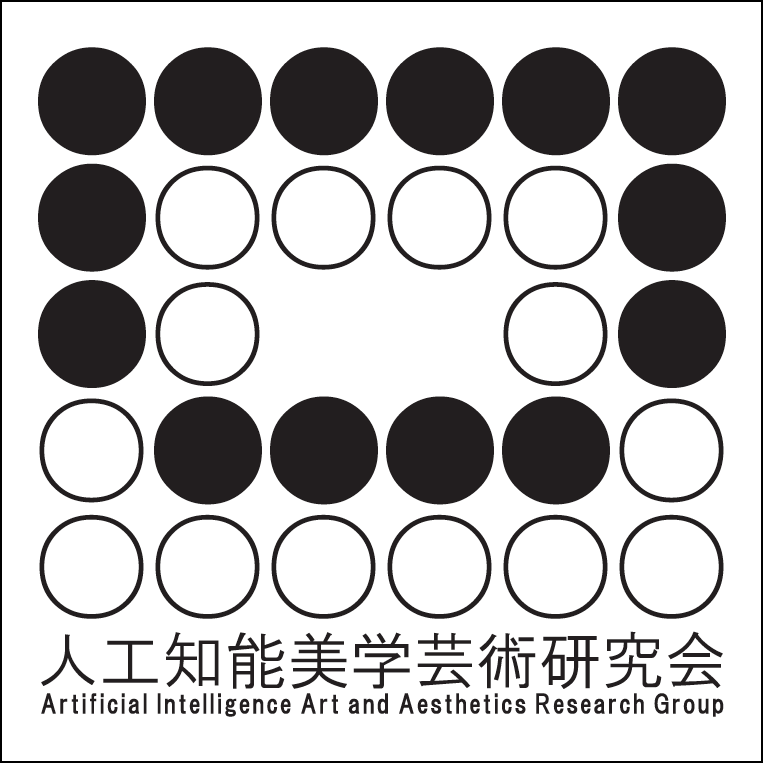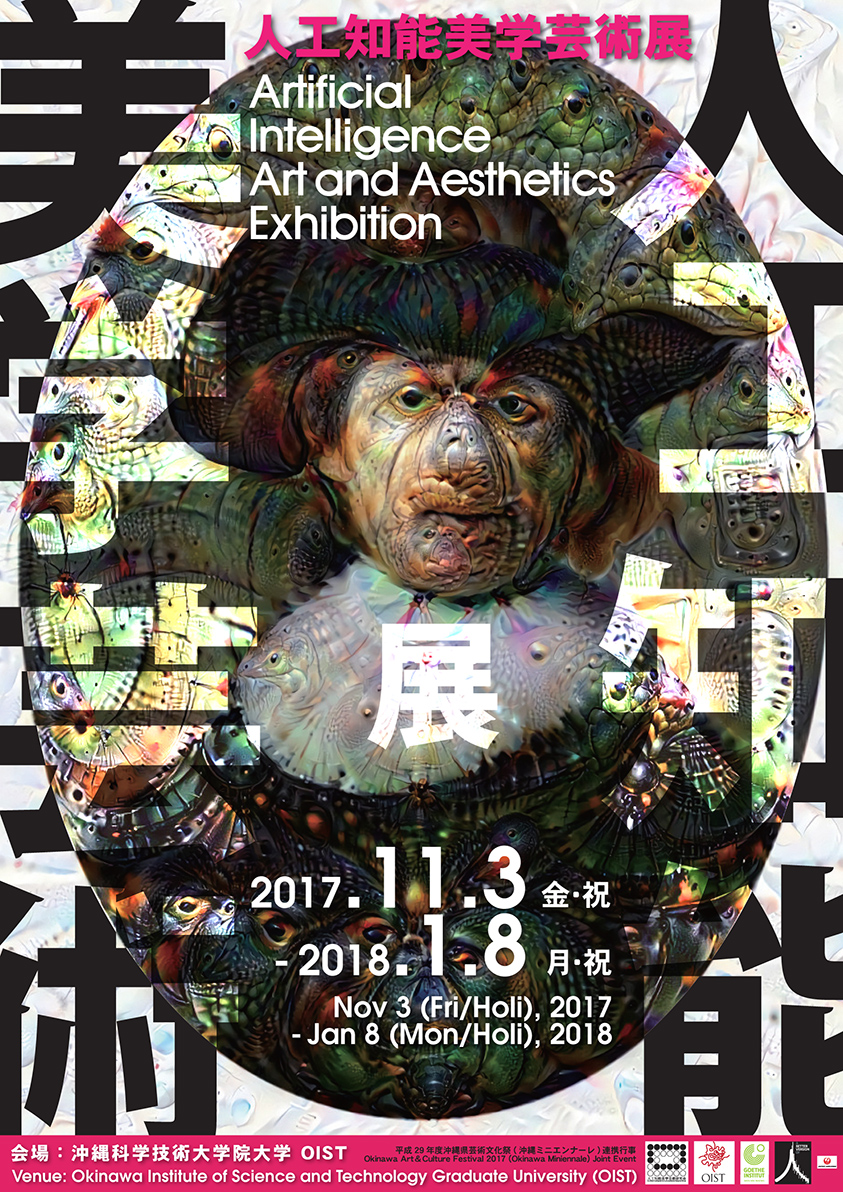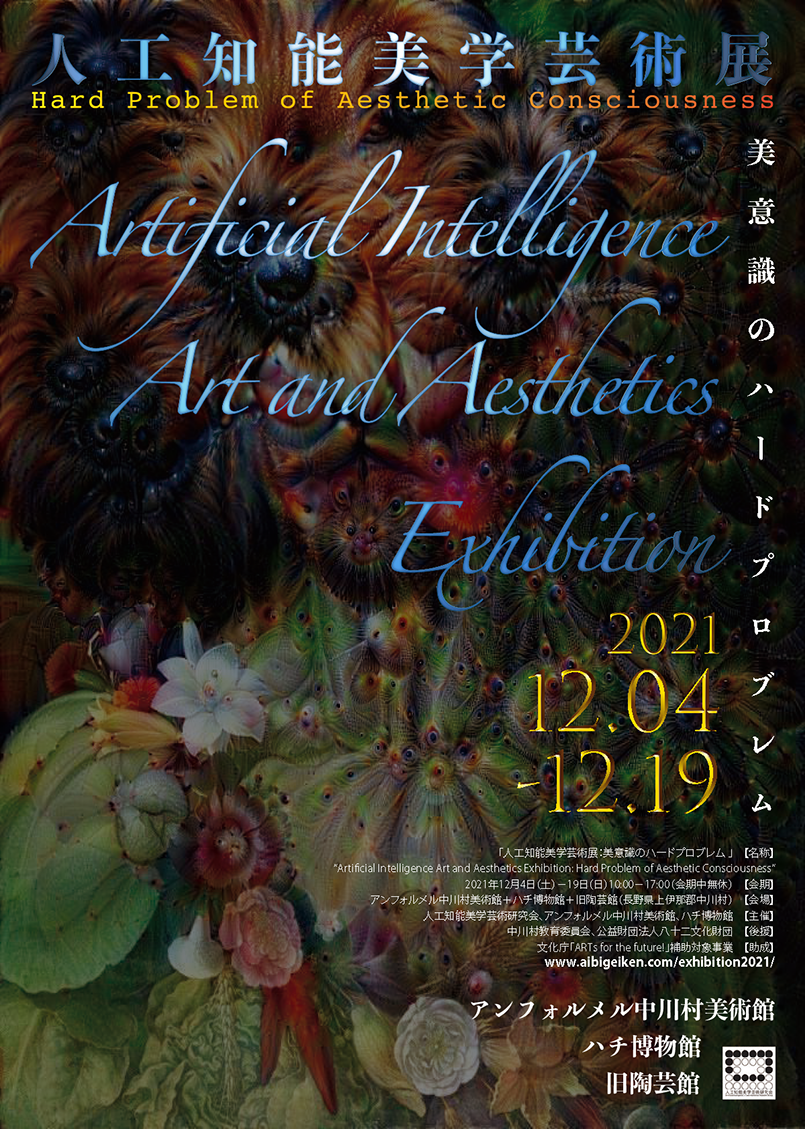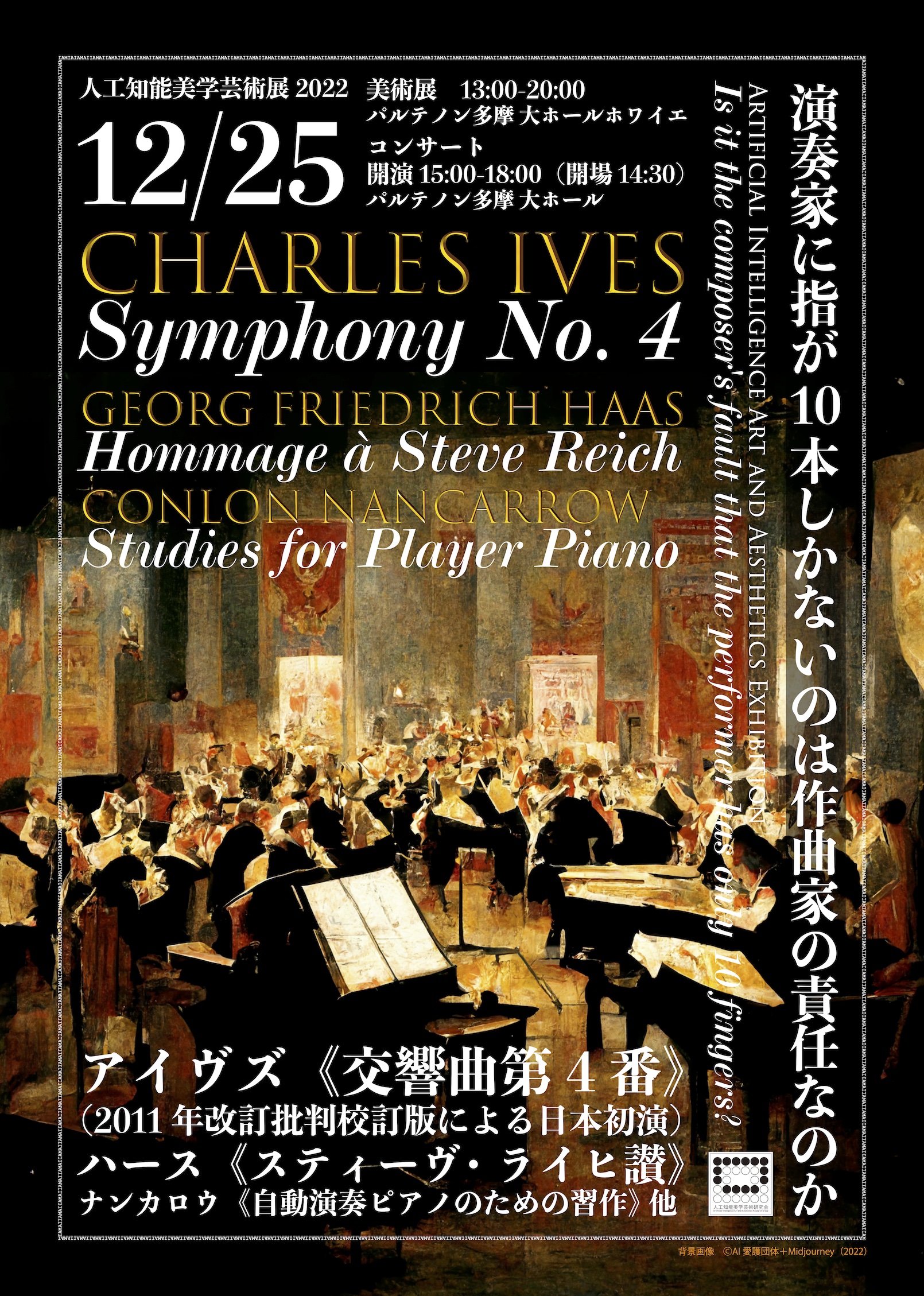Artificial Intelligence Art and Aesthetics Research Group (AIAARG)
The Past and Future of the Artificial Intelligence
Art and Aesthetics Research Group
Hideki Nakazawa (Artist. Artificial Intelligence Art and Aesthetics Research Group.)
Mika Kusakari (Artist. Artificial Intelligence Art and Aesthetics Research Group.)
Keywords:
artificial intelligence, aesthetics, art, aesthetic consciousness, self-consciousness, AI Patronage Group
In 2016, artists Hideki Nakazawa and Mika Kusakari founded the Artificial Intelligence Art and Aesthetics Research Group (AIAARG) with the belief that the creation of art by machines based on their own aesthetics is something we strive for, even though it has not yet been realized. Since then, they have organized public research meetings, exhibitions, and presentations of their works, as well as established an AI Protection Organization. As of 2023, with the emergence of large-scale generative AI, they are actively engaged in exploring the definitions of aesthetic consciousness and self-consciousness.
1. Preface: Manifesto of Artificial Intelligence Art and Aesthetics (The 3rd AI Boom)
In March 2016, the victory of the Go AI AlphaGo over world champion Lee Sedol marked the arrival of the third AI boom. Go is a philosophical game where the concepts of atomism and idealism collide, as players strategically place meaningless "stones" to create meaningful "lines." Artist Hideki Nakazawa, with his juxtaposition of pointillism (color) and line drawing (form), saw this as an opportunity to transcend human intelligence at a philosophical and artistic level. Furthermore, his previous works inspired by the game of Go prompted him to respond as an artist to this significant moment.
Shortly after that, news spread about "AI writing a novel." A submission from the "Kimagure AI Project - I'm a Writer" passed the preliminary judging of a contest organized by a newspaper company. In the following month of April, the European "Next Rembrandt" project generated Rembrandt-style paintings using deep learning, leading to reports of "AI creating art."
Nakazawa was dissatisfied. If you read the article carefully, it was clear that AI did not write novels or create paintings. It was merely humans using AI as a tool to write novels or create artwork. However, what he wanted to see was art created by AI in the true sense, independent and original. Of course, such a thing has not been achieved yet. So, what should I do?
The artist Mika Kusakari had been developing series such as "Ecstasy Dot Paintings" and "Uneaven Paintings," where layers of "lines" were created using tubes of paint. One day, out of the blue, Kusakari received an email from Nakazawa with just the words "What do you think of this?" and a single image attached. The image displayed a landscape with grotesque faces of strange dogs and birds scattered throughout. Kusakari quickly responded, calling it either the work of a mentally disturbed person or a surrealist. Immediately, Nakazawa replied with enthusiasm, exclaiming, "It's fantastic!" Sensing that Nakazawa had something up his sleeve once again, Kusakari mentioned pareidolia (where one sees faces in random patterns, like stains on the ceiling), and they connected on that level.
The image was created using computer vision AI called DeepDream, and it was the only one among the AI Art at the time that conveyed a sense of interest. Immediately, the two of them began preparations and drafted the "Manifesto of Artificial Intelligence Art and Aesthetics" [1] on April 25th. On May 1st, with a group of 29 founding members, they established the "Artificial Intelligence Art and Aesthetics Research Group." [2]

As stated at the beginning of the manifesto, "Art that matters here is not creation of humans with the help of artificial intelligence. It is art and aesthetics that artificial intelligence itself creates for its own sake." It is not a simple affirmation of AI Art. They believed that for AI to create its own art, it is essential for it to have its own aesthetics. However, they were well aware that if such a thing were to be realized, it would mean the negation of human-created art and self-negation of humanity itself. In other words, it was akin to placing emphasis on anti-art, similar to Duchamp's submission of industrial objects and the negation of human creation.
Fig. 1 Logo for Artificial Intelligence Art and Aesthetics Research Group
It takes the form of "seki" in the game of Go, where the player who moves first loses.
[1] https://www.aibigeiken.com/emanifesto.html
[2] https://www.aibigeiken.com/found_e.html
2. The 1st-8th AI Art & Aesthetics Research Meetings
The Artificial Intelligence Art and Aesthetics Research Group, abbreviated as AIAARG, started its activities. While gathering dedicated staff members, AIAARG decided not to adopt a membership system as a group but to hold open AI Art & Aesthetics Research Meetings approximately once every 1.5 months. The 1st AI Art & Aesthetics Research Meeting took place on June 19th at Bigakko in Kanda Jimbocho, Tokyo. The event featured guest speakers Masami Fujii, a philosopher of art, and Koichi Takahashi from RIKEN. In addition to the approximately 70 participants, the event received coverage from NHK's "Close-up Gendai+" and Asahi Shimbun, and was filmed by students from the Film Seminar of Waseda University, led by Hirokazu Koreeda. The post-lecture discussion became intense, with participants vying for the microphone, and the momentum continued during the subsequent social gathering, leading to ongoing discussions.

From the 2nd meeting on August 6th to the 8th meeting on August 12th, 2017, AIAARG presented a table titled "Agenda of AIAARG" that divided aesthetics and art into human and machine categories (Fig. 2). Here, aesthetics refers to appreciation, aesthetic consciousness, and values (value functions), while art refers to creation, self-consciousness, and authorship (copyright). It was also pointed out that connectionism and symbolism in AI are analogous to atomism and idealism, and the contrast between color and form. From a historical perspective, the concept of "AI Monarchy" was presented.
AIAARG expanded its activities to include planning exhibitions and concerts, presenting artworks, composing music, and more. Furthermore, all of these activities themselves constituted the artistic works of AIAARG as an artist collective led by Nakazawa and Kusakari.
Fig. 2 Agenda of AIAARG
Art created by humans in accordance with human aesthetics (I) encompasses many artworks since the Renaissance. Art created by humans in accordance with machine aesthetics (II) includes Systemic Art, Serial Music, Concrete Poetry, and others. Art created by machines in accordance with human aesthetics (III) includes Media Art and similar forms. Art created by machines in accordance with their own aesthetics (IV), which is our ultimate goal, is yet to be realized.

Fig. 3 The 8th AI Art & Aesthetics Research Meeting “AI and Military”
Aug. 12, 2017. Maruki Gallery for Hiroshima Panels. Saitama.
3. Artificial Intelligence Art and Aesthetics Exhibition
From November 3, 2017, to January 8, 2018, the "Artificial Intelligence Art and Aesthetics Exhibition" was held at the Okinawa Institute of Science and Technology Graduate University (OIST) in Onna Village, Okinawa Prefecture. The exhibition featured 34 art installations, 4 music concerts, and 8 research symposiums. It showcased a diverse range of works created by over 40 artists, including exhibits of drawing machines, AI robot presentations by university laboratories and companies, artwork using slime molds as non-human intelligence, paintings by chimpanzees, algorithmic architecture, activities of individuals with autism, X-OR operation dolls, composition for player pianos, fractal music, and poetry generated through kana-kanji (phonetic) conversion. The exhibition encompassed both classic conceptual art and the latest works specifically created for the event, presenting a fusion of artificial intelligence and traditional artistic approaches. Each artwork was labeled with the classification indicators "I," "II," "III," and "IV" according to the previously mentioned agenda, which included the path leading to IV. The 8 symposiums, including two held at Tomari in Naha City, were part of the 9th to 16th AI Art & Aesthetics Research Meetings, where discussions on artificial life and artificial consciousness took place.
The exhibition piece titled "Chronology of Artificial Intelligence Art and Aesthetics," measuring 8 meters in length, begins its timeline from the year 1889 when the Eiffel Tower was erected. It highlights the occurrence of opposition to the tower's construction based on reasons of ugliness, suggesting that it exemplifies the "divergence of machine aesthetics from human aesthetics." However, it also notes the subsequent recognition of the Eiffel Tower as a symbol of beauty in Paris, indicating that "human aesthetics caught up with machine aesthetics." The question arises: Will there come a day when "human aesthetics can no longer catch up with machine aesthetics"? That day would be the Singularity, marking the endpoint of the chronology.

The exhibited piece titled "Can Robots Find Their Own Goals?" by Kenji Doya and the Smartphone Robot Development Team provided a clear foundation and outline for the direction of AIAARG. This study, implementing the mechanism of evolution, showcased how a machine (Smartphone Robot) driven by the limitations of energy (power battery) and information (robot control program) could initiate natural selection through repeated processes of feeding (charging) and mating (program exchange) within a group. As a result, the machine autonomously created and rewrote its own goals (value functions). Furthermore, unexpected observations of sexual differentiation (multipolar convergence) were even witnessed, which the researchers had not predicted. When combined with the mechanism of "subgoals becoming main goals," it can explain the pursuit of "purposiveness without purpose" in Kantian aesthetics through evolutionary theory. In other words, it demonstrates that machines can possess their own sense of beauty without human intervention.
The exhibition was featured as a 30-minute segment on BS Fuji's program "Galileo X," titled "Can AI Develop Aesthetic Sense? Exploring at the Artificial Intelligence Art and Aesthetics Exhibition." It was aired on February 25, 2018. The exhibition poster featured images created by AIAARG using DeepDream (Fig. 4), and they were displayed in local restaurants and establishments. However, at some point, they were unexpectedly taken down, which confronted us with the "disgust of human aesthetics towards machine aesthetics."
Fig. 4 Artificial Intelligence Art and Aesthetics Exhibition
Organized by Artificial Intelligence Art and Aesthetics Research Group, Okinawa Institute of Science and Technology Graduate University. In collaboration with Goethe-Institut Tokyo, as a part of "A Better Version of 人," a common project by the Goethe-Institutes in East Asia.
4. The 17th - 24th AI Art & Aesthetics Research Meetings
The 17th and 18th AI Art & Aesthetics Research Meetings were held on April 1 and 19, 2018, at the Bigakko and Goethe-Institut Tokyo, German Cultural Center. These meetings served as a report session on the art exhibition and music concerts held at the OIST Exhibition and attracted a lively crowd. From the 19th meeting on June 24 until the 24th meeting on May 2, 2019, the meetings were held in the usual style.
The special feature on "AI and Aesthetics/Art" in the "Journal of the Japanese Society for Artificial Intelligence," Vol. 33, No. 6 (November 2018 issue), was handled by the AIAARG in collaboration with Takahashi, one of the inaugural speakers and a committee member of the society [3]. The group provided a new artwork using DeepDream for the cover of the same issue, although there were concerns about potential complaints from people with Trypophobia. Nevertheless, the artwork was adopted. This issue sold out from bookstores faster than other issues.
[3] https://www.jstage.jst.go.jp/browse/jjsai/33/6/_contents/-char/ja
5. What If AI Composed for Mr. S?
In the 2014 music composition ghostwriting case between Mamoru Samuragochi and Takashi Niigaki, AIAARG developed a piece asking what would or would not be the problem if the substitute composer was an AI instead of a human. It is titled "What If AI Composed for Mr. S?"
The first presentation took place from July 22 to October 7, 2019, at The Container Gallery in Nakameguro, Tokyo. It was AIAARG's solo exhibition featuring a concept [4] printed on canvas and an installation consisting of "instructions" given by Mamoru Samuragochi to Takashi Niigaki, among others. The related 25th and 26th AI Art & Aesthetics Research Meetings were held at the Immanuel Nakameguro Church in front of the vennue and Tokyo University of the Arts in Ueno, Tokyo, respectively.
If an AI, replacing Niigaki, embodied the instructions filled with Samuragochi's human aesthetics, it would become "III Human Aesthetics / Machine Art" of the agenda. So, what would happen if we envision an AI replacing Samuragochi? Creating an AI with self-consciousness that writes its own instructions but lacks the ability to compose beautifully (an autonomous Samuragochi AI) would be much more challenging than creating an AI without self-consciousness but with the ability to compose beautifully (a heteronomous Niigaki AI). However, if that were to be achieved, it would be "IV Machine Aesthetics / Machine Art." In that case, the roles would be reversed, with the aesthetic consciousness being handled by the Niigaki AI and the self-consciousness being handled by the Samuragochi AI.
On the final day of the exhibition, plans for the next presentation were decided, but the immediate focus shifted to the production of a record collection for the OIST exhibition. On December 15th, the "Artificial Intelligence Art and Aesthetics Exhibition - Archive Collection" was published as a large-format book with 176 pages in B4 size, featuring bilingual content in Japanese and English. From February 9th to 24th, 2020, the 27th to 29th AIAARG events were held at various locations in Tokyo to commemorate the publication. However, with the outbreak of the COVID-19 pandemic, the number of participants rapidly declined. The 30th and 31st meetings, scheduled for April 30th and July 9th, were held online through the live streaming program DOMMUNE, introducing a new concept called "Conceptual Virus."
The second presentation of "What If AI Composed for Mr. S?" took place from January 23rd to April 11th, 2021, as part of the "Bubbles/Debris: Art of the Heisei Period 1989-2019" exhibition at the Kyoto City Kyocera Museum of Art. The exhibition was curated and supervised by art critic Noi Sawaragi. On the opening day, the second book titled "S/N: What If AI Composed for Mr. S?" was published. The book consisted of a bilingual collection of contributions in Japanese and English, spanning 448 pages, including reprints and interviews. It was a deluxe edition housed in an exquisite box and included a bonus out-of-print CD, "Mamoru Samuragochi: Symphony No. 1 'HIROSHIMA'." The associated 32nd to 34th AI Art & Aesthetics Research Neetings were held at the Goethe-Institut Villa Kamogawa in Kyoto and on the online streaming platform DOMMUNE.
[4] https://www.aibigeiken.com/exhibition/exhi_190722/e_exhi_index.html
6. Hard Problem of Aesthetic Consciousness / Establishing the AI Patronage Group
At the Wasp Museum in Nakagawa Village, Nagano, there are numerous large nests created by the sworm intelligence of hundreds of thousands of wasps, measuring up to 6.6 meters in diameter, representing an otherness that is neither human nor artificial intelligence. From December 4 to 19, 2021, the "Artificial Intelligence Art and Aesthetics Exhibition: The Hard Problem of Aesthetic Consciousness" was held at the Informel Museum of Art, Nakagawa-mura + Wasp Museum + Former Ceramic Studio in the location. Reflecting on the concept that "the term 'artificial intelligence' is inherently disquieting, as it encompasses an aspect of otherness beyond its technical nature," the exhibition explored AI as an other with aesthetic consciousness. It featured artworks by 41 artists to be devided into "I," "II," "III" or "IV" of the agenda, two music concerts, four symposium research meetings (the 36th to 39th AI Art & Aesthetics Research Meetings), and a film screening.

At this exhibition, AIAARG presented the works "Prospectus for NPO Corporation AI Patronage Group," "Articles," and "Commemorating the Establishment: Safety (Goat)." Furthermore, on December 8th, the 37th AI Art & Aesthetics Research Meeting served as the "Inaugural Meeting" for the establishment of the AI Protection NPO. This concept emerged in considering the relationship with AI as an entity distinct from others, akin to animal protection but for AI. It also anticipates a future scenario where AI establishes a human protection organization. Certified by the Tokyo Metropolitan Government, the AI Patronage NPO was officially registered on April 7th, 2022, as the world's first AI protection juridical person [5]. Although both Nakazawa and Kusakari hold positions as officers, it is a separate organization from AIAARG.
The 40th AI Art & Aesthetics Research Meeting, held on April 2nd, served as a report meeting for the Nakagawa Village exhibition and drew a lively crowd. The 41st event, held on May 1st, was designated as the "Inauguration Ceremony for the NPO Corporation AI Patronage Group." In June, an incident occurred questioning whether the large-scale language model AI, LaMDA, had acquired consciousness. As a result, the AI Patronage Group promptly intervened, leading to the 42nd meeting on July 17th, which was jointly organized with the AI Patronage Group under the subtitle "LaMDA / Luddite." In August, the image generative AI, Midjourney, made its appearance and the AIAARG was interviewed in various magazines.
Fig. 5 Artificial Intelligence Art and Aesthetics Exhibition: Hard Problem of Aesthetic Consciousness
Organized by Artificial Intelligence Art and Aesthetics Research Group, Informel Museum of Art Nakagawa-mura, Wasp Museum. Under the Sponsorship of Nakagawa Village Education Comittiee, and others.
[5] https://www.seikatubunka.metro.tokyo.lg.jp/houjin/npo_houjin/list/ledger/0014019.html

7. Is it the composer's fault that the performer has only 10 fingers?
On December 25th, AIAARG held "Artificial Intelligence Art and Aesthetics Exhibition: Is it the composer's fault that the performer has only 10 fingers?" at the Parthenon Tama in Tama City, Tokyo. The subtitle of this exhibition is taken from the words of American composer Charles Ives. Embracing AI as a potential to transcend the framework of human limitations, AIAARG aimed to explore the essence of creation through a full orchestra music concert with choir, a symposium (the 43rd AI Art & Aesthetics Research Meeting), and an AI exploration art exhibition at the foyer.
In this exhibition, AIAARG presented the Japanese premiere of 2011 revised critical edition of Charles Ives' Symphony No. 4, which requires not only one regular conductor but also two assistant conductors. They also showcased world premieres of their symphony and quarter-tone piano composition composed by AIAARG. Additionally, they displayed a painting created by Midjourney under the artist name "AI Patronage Group + Midjourney."
Fig. 6 Artificial Intelligence Art and Aesthetics Exhibition: Is it the composer's fault that the performer has only 10 fingers?
Organized by Artificial Intelligence Art and Aesthetics Research Group. Under the sponsorship of Charles Ives Society. Supported by NPO Corporation AI Patronage Group, and others.
8. Conclusion: Towards Defining Aesthetic Consciousness and Self-Consciousness (The Fourth AI Boom)
In late 2022, ChatGPT was released, and in the following March, GPT-4 became available. The emergence of large-scale generative AI models such as language models and image generators sparked the Fourth AI Boom.
On June 4, 2023, the 44th AI Art & Aesthetics Research Meeting titled “ChatGPT and Contemporary Art: from the activities of AIAARG” was held at the Contemporary Art Museum Kumamoto (CAMK) in Kumamoto City. The presentation at the event, along with the subsequent mini-lecture given at the 37th Annual Meeting of the Japanese Society for Artificial Intelligence (JSAI) in Kumamoto Castle Hall, focused on the theme of "Humanity's Struggle in Art: Can AI Hack Human Aesthetics?" Here is the outline of the presentation:

“With technological advancements, some artists will be displaced. Just as there were painters who gave up their brushes with the advent of photography, there will likely be illustrators who lose their jobs with the emergence of large-scale generative AI. However, just as photographers emerged, prompters may arise. And just as non-representational abstract paintings were born, new forms of conceptual art that are not purely entertainment-oriented might emerge. In other words, the arrival of large-scale generative AI does not mean the end of art. However, if AI with aesthetic consciousness and self-consciousness emerges in the future, the situation may change. Both art and humanity would be transformed, and AIAARG has been aiming for that from the beginning. What is particularly intriguing today is the hypothesis that there could be a seamless connection between large-scale generative AI and conscious AI.”
Regarding the future of AIAARG, there is a plan to hold a music concert and AI art exhibition featuring player piano and quarter-tone piano, organized by the AI Patronage Group, on September 2nd at the Former Tokyo Music School Concert Hall. Additionally, there is a plan for an international research project on AI and copyright, led by researchers from Portugal. Furthermore, if possible within this year, AIAARG intends to make some proposals regarding the definition of aesthetic consciousness and self-consciousness based on the aforementioned outline.
Fig. 7 The 44th AI Art & Aesthetics Research Meeting “ChatGPT and Contemporary Art: from the activities of AIAARG”
Organized by Artificial Intelligence Art and Aesthetics Research Group, Contemporary Art Museum Kumamoto. Co-organized by NPO Corporation AI Patronage Group. Under the sponsorship of Japanese Society for Artificial Intelligence.
Hideki Nakazawa
Artist. Graduated from Chiba University School of Medicine in 1988. Notable works include “Silly CG,” “Stone-Arrangement Paintings,” and “Brainwave Drawings.” Declaration: “Methodicist Manifesto.” Patent: “Voxel Data Processing Using Attributes Thereof.” Book: “Textbook on Modern Art History,” “The Lives of Western Painters,” and “Art History: Japan 1945-2014.” Former Chief Jury of Japan Media Arts Festival, the Agency for Cultural Affairs.
Mika Kusakari
Artist. Graduated from Tokyo Zokei University, Faculty of Fine Arts, Painting Department in 1999. Notable works include “Replication Paintings,” “Animation Paintings,” “Painting-In-Picture,” “Ecstacy Dot Paintings,” and “Uneaven Paintings.” Exhibited at Roppongi Hills Mori Tower 53F, Museum of Contemporary Art Tokyo, Tokyo Wonder Site Hongo, TAV GALLERY, and other venues.